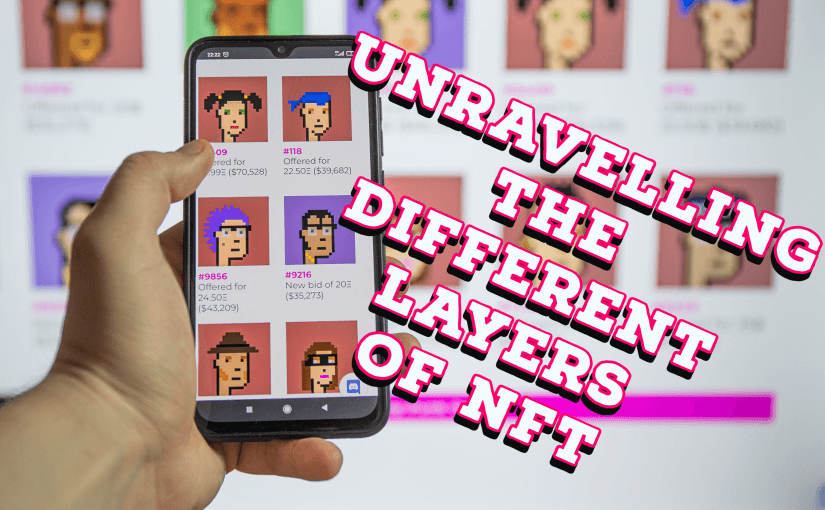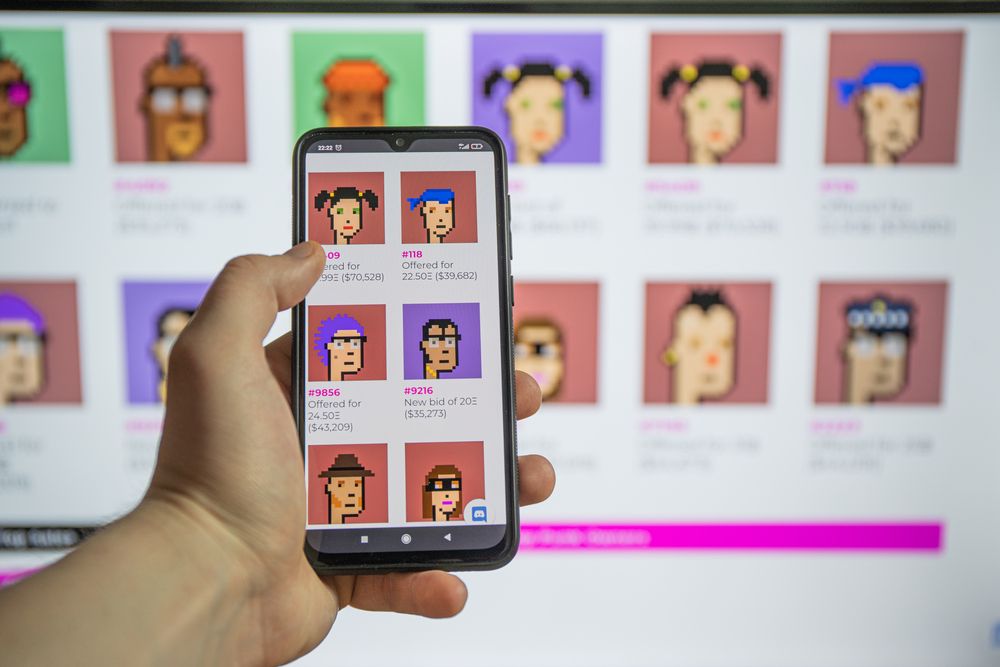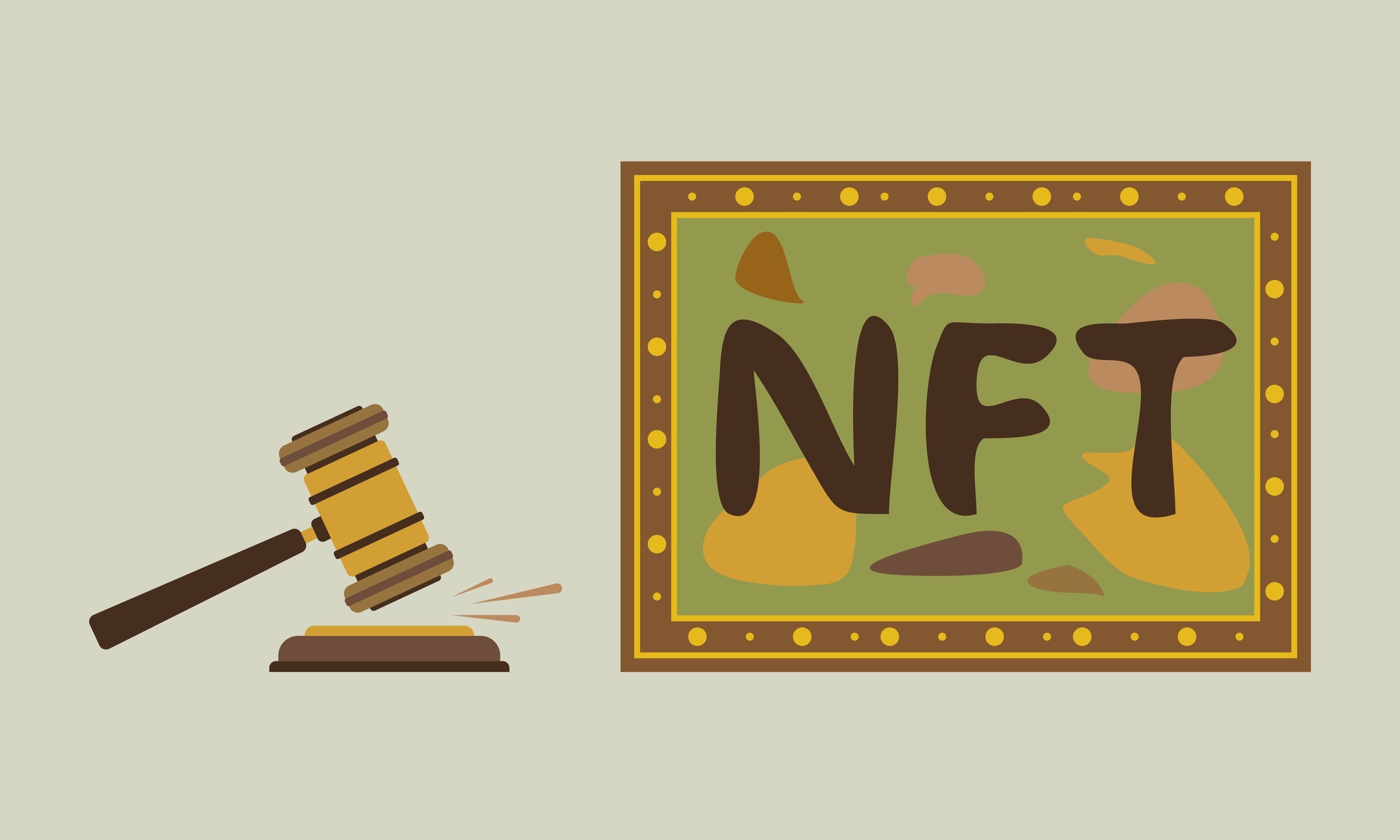Copyright, DeFi And Securities: Unravelling The Different Layers Of NFT

It is undeniable that non-fungible tokens (NFTs) have become one of the major highlights of the crypto and blockchain movement in recent months. The sheer possibility of expanding the ownership rights that blockchain and tokenization offer has elevated the concept of non-fungible digital assets to mainstream status in record time.
Bearing in mind the mainstream appeal of NFT, it is easy to forget that this technology or blockchain feature is still relatively nascent. Therefore, several NFT components require more modifications and in some cases, a lot more clarification. In this guide, we will explore the evolution of the NFT market and identify those issues that stakeholders might need to resolve to achieve more mainstream success.
The Rise Of NFTs

Although NFTs have been around for over 4 years, it was not until the explosion of crypto art in 2020 that we began to witness a steady rise in their demand. At the beginning of this era, more emphasis was placed on the autonomy that NFT offers digital artists and other content creators. For many, the goal is to capitalize on the flexibility of tokenizing digital art in order to improve their chances of monetizing their intellectual property.
Unlike the traditional art scene, the emergence of NFTs eliminates the inputs of third parties when selling or buying digital art. With this possibility, the process of transferring or monetizing the ownership of tokenized digital arts is fast, cheap, and seamless. More importantly, it exposed content creators to a global network of collectors, art lovers, and crypto proponents. A typical decentralized NFT marketplace is available globally due to its censorship-resistant capability. As such, whether you are from India, Africa, the USA, or Europe, you can rest assured that your background or location would not impede your chances of showcasing your arts and monetizing them.
While the crypto art movement kicked off the NFT hype, the buzz has since moved on to other sectors. Currently, crypto collectibles are somewhat the most sought-after NFTs. In particular, avatar NFTs frequently feature in the list of the most expensive NFT sales. For the uninitiated, avatar NFTs are often headshots of cartoon or pixelated characters. An example is CryptoPunk — a series of unique, tokenized, and pixelated characters regarded as one of the first sets of NFTs ever created. Remarkably, one of the characters from this collection sold for a whopping $11.5 million in June. So the question is: Why will anyone in their right senses pay such a ridiculous amount of money for an avatar token, which some say does not have any intrinsic value?
Perhaps, the explosion of avatar NFTs demonstrates that NFT collectibles and artworks are the new digital status symbol. This sentiment was aptly explained by David Z. Morris in an article titled “Why Avatars Dominate the NFT Market.” He wrote:
“The dominance of avatars is a powerful window into this mysterious, seemingly nonsensical explosion of interest. A set of social norms is quickly emerging, primarily on Twitter, that assumes you only display an NFT in your avatar if you own it. Getting caught posting something you don’t own is a reputational risk, and Crypto Twitter is a significant professional venue, so there’s a very clear status game afoot: The people who can display the most expensive NFT are showing off just how rich and successful they are. NFTs, then, are tapping into some of our deepest instincts: Humans, just like our close chimpanzee relatives, are obsessed with social status and hierarchy.”
Morris added that the issuance structure of avatar NFTs and the rarity that it incorporates are other reasons why they are widely coveted by crypto proponents:
“Avatar NFTs leverage this with their issuance structure, which CryptoPunks somehow got right the first time out of the gate. Most of the avatar series are issued in large but strictly limited quantities of roughly 5,000 to 10,000. And they’re mostly algorithmically generated from a set of “features” with varying rarities, which creates a fairly simple internal hierarchy. At the same time, the wide variation in features makes it easier for buyers to choose something that speaks to their identity or taste.”
Copyright Or Intellectual Property Laws For NFT

Copyright Or Intellectual Property Laws For NFT
When it comes to NFTs, another major talking point is the lack of copyright enforcement laws. SInce NFT is increasingly being adopted in the creator economy, it is imperative to understand the rights that come with owning NFTs. Many fail to understand that although they have acquired the NFT version of a particular work, it does not guarantee the outright ownership of the intellectual property.
More often than not, the creators of NFTs do not issue copyrights to buyers, that is if the right is even theirs to give. In most cases, NFT creators are not the author of the intellectual properties that anchor the tokens sold on NFT marketplaces. Hence, there is no way the buyer can receive the right to own or duplicate the original work. Instead, what buyers commonly receive is the right to own the NFT.
Tatiana Revoredo, one of the founding members of Oxford Blockchain Foundation, expanded on this topic when she wrote:
“Here, it is interesting to know that you are not obtaining ownership of the asset itself, nor even getting the intellectual property rights of that work. And, in this sense, the reasoning is no different from the acquisition of a physical piece of art in the traditional market. If a traditional painting in an auction is bought, the buyer does not receive the intellectual property rights of the asset itself. The buyer has the right to hang the new painting on their wall, but not the intellectual property of that painting, unless it has been commissioned. Therefore, it is not allowed to make posters of that painting on the wall. No one can’t create nor change it.”
Revoredo went on to advise interested NFT buyers to make inquiries about the rights that come with owning NFT from either creators or authors. Alternatively, Harsch Khandelwal, CEO of Ureeqa, proposed that rights should be hardcoded into NFT smart contracts to clear any doubt surrounding the permissions transferred to buyers:
“Validating and verifying copyright ownership must be a part of the NFT-minting process — for example, by bringing human beings into the minting process to gather evidence and support that serve as a package of proof that the person minting the NFT has the necessary permissions to do so. This package of proof is then stored online, and the NFT provides a link to the supporting documents. NFTs minted in this way are portable and can be sold and exchanged on any Ethereum-compatible NFT marketplace. In this way, artists are protected from unauthorized minting and purchasers can be sure that they are acquiring an NFT that has been responsibly minted by the authorized owner of the copyright.”
Furthermore, Amy Madison Luo, general council to Centre, in an article published on Coindesk, advised creators to take the time to understand the type of rights they transfer to marketplaces when minting NFTs:
“It is important for creators to read the terms of the marketplace they’re working with, and to make sure their rights are reserved to avoid ambiguity at a later date. Most of these marketplaces require creators to grant a right to them, broadly speaking, to use, reproduce, modify, publish, display and distribute your “content” on a worldwide, non-exclusive and royalty-free basis. Normally, this is so these marketplaces can actually post the NFT on their platform for sale, use the creation as a marketing and advertising to promote their marketplace, and occasionally embed the creation within indexes for better user experience and ease of search. While most marketplaces limit the use to these purposes, some do not and even allow them to further sublicense these rights to third parties. This means that while creators largely retain their IP rights vis a vis the collectors of their NFT, they do specifically grant these rights to the marketplace on which they sell their art.”
Pay-To-Earn (P2E) NFT Games

Pay-To-Earn (P2E) NFT Games
Also, the ongoing NFT buzz can be linked to the emerging play-to-earn (P2E) gaming genre. Apparently, more game developers have begun to integrate elements of NFT into their games to provide an avenue for players to earn crypto while they are playing. Thanks to this game model, players can outrightly own in-game assets and sell them on marketplaces for cryptocurrencies. Before the advent of play-to-earn games, game developers retain the sole ownership of in-game assets. In most cases, these assets are non-transferrable. However, thanks to the ownership rights that NFT provides, we are witnessing the explosion of an NFT economy anchored to games that let their players mint, earn, breed, or win in-game assets and trade them on marketplaces for real money.
In some cases, the games adopt decentralized finance (DeFi) mechanisms such that players can unlock dynamic yield earning opportunities with their NFTs. Dragos Dunica, the cofounder of Dappradar, recently commented on the convergence of DeFi and NFTs, stating:
“Right now, we are seeing a convergence of DeFi mechanics and gaming mechanics to drive interactions and usage. The most popular titles are creating environments where users can not only take ownership of a unique NFT but also leverage that within the same platform for a reward.”
Like Dunica, Evan Luthra believes that the intersections where NFT and DeF meet promise exciting and innovative opportunities for both game developers and gamers alike. He wrote:
“Play-to-earn games are the latest innovation in the blockchain gaming industry. It will revolutionize how people interact with the economies of their favorite games. It has ensured and embraced the concept of an open economy, making sure players who bring value to the gaming world are rewarded financially. This has, in turn, seen a domino effect of sorts on the crypto markets as a lot of people are trooping to these games (regardless of how gaming-oriented they are) to play and make money for themselves.”
Jesse Johnson, founder and COO of Pixelcraft, the creator of Aavegotchi, while expressing his thoughts on the emerging NFT market, told Cointelegraph that gaming is the biggest application of NFT. He stated:
“Businesses can utilize NFTs for many different uses, but the biggest of all is gaming. The ‘play-to-earn’ aspect of NFTs will be revolutionary in the coming years. Through this transitioning from static digital collectibles to tokens, real utility is created and will lead to the next generation of NFTs, especially as more companies and corporations get involved.”
Craig Russo, director of innovation at PolyientX, also commented that earning while having fun is a possibility that could potentially spark the next growth phase of the emerging NFT market:
“A user’s ability to earn into token economy cash flows by putting work into a game will be a fundamental driver of this new virtual existence. I am particularly interested in the crosstalk between NFTs and DeFi, which will fuel the next major growth inflection point for the NFT market.”
However, he added that there is a long way to go before crypto P2E games can compete with their non-blockchain counterparts in terms of engagement. According to Russo, much need to be done to fully expand on the current successes and build a vast P2E game market that cut across all gaming niches:
“Play-to-earn is a high-potential area within the NFT space, and we’re already seeing some great market validation, which has resulted in a price surge across most gaming-related tokens. However, play-to-earn gaming is very niche, and substantial inroads into the mainstream gaming ecosystem will be required before the level of adoption rivals that of non-blockchain gaming segments such as esports.”
Speaking of the possible improvements that can be made on the existing P2E gaming structure, Derek Lau, game director for Guild of Guardians, a mobile NFT-based RPG, explained that developers can build a self-sustaining economy around their games and empower players to implement a plethora of activities with their NFTs:
“Video games have the potential to take NFTs and make them a major cornerstone of their economy, which could give quite a bit of power back to the players, as in-game purchases will genuinely be “owned.” As NFTs, these items can be resold on secondary markets, loaned out, be transferred outside of the game and essentially become a tangible investment. Developers can get even more creative. For example, items can be fractionalized, pooled into an index fund, exist across multiple games, evolve each time they are traded, and more.”
Nonetheless, it is not enough to rely heavily on the earning opportunities of P2E games for sustainable growth. According to Lau, developers must learn to adopt blockchain as an added element of their game. He argued that the reason many blockchain games are yet to attract a strong following is that they are packaged and heavily marketed as blockchain games:
“A significant issue for many of the currently offered blockchain games is just that — they are being created and promoted as blockchain games, not great games where blockchain is just one element. Companies focus on the ownability, tradeability and money-making aspects, plugging in basic gameplay mechanics with visuals comprised of assets from the Unity Asset Store or pixel artwork. It may attract those interested in making money, but many gamers take one look and go back to their mainstream titles.”
For Lau, such an approach automatically restricts P2E games to a single niche. Also, it brings about a parasitized economy where experienced players profit at the expense of new and inexperienced players. Lau explained:
“It’s not just that blockchain game developers are failing to win over gamers, either. These titles are often inherently unsustainable. Think about it: If the primary draw is the possibility of money-making, then these platforms will naturally attract those who want that money above other aspects of the game. This means that their sole goal is to extract as much value from the platform as possible while contributing as little as possible. We’re talking trading and crypto gambling games rather than traditional “AAA” games… Under this system, it is often more experienced players who are profiting off new players, and those who are “bad” at making money will leave the ecosystem. With no real gameplay draw, the flow of those new players who are interested will quickly dry up. Once the value of native assets or currency has been debased due to this process, the original exploiters will almost certainly move on to some newer game where they can do it all again, leaving the previous title a relative ghost town. If we’re ever going to see a broader interest or significant developer support, these game models need to change.”
The sensible way to avoid this limitation is to focus on creating games that would ordinarily appeal to mainstream gamers and then introduce NFT features as added elements. With this, players can still play the game for the fun of it, whether they generate profit or not:
“The NFT games of tomorrow need to be fun. Users need to be saying, “Honestly, I would play it anyway, but the fact that I own what I earn makes it even better!” Anything less than this reaction is going to result in a struggle to retain players when there are already so many entertainment options available. Offering gamers a chance to earn while doing the leisure activity they enjoy is the real selling point here — not a digital replacement for a day job.”
While these sentiments are somewhat valid, a lot of P2E games have built their entire operation around the NFT-focused model criticized by Lau. Perhaps, it can be argued that these games have become popular in countries like Vietnam and the Philippines largely because of the high possibility of generating earnings consistently. An example is Axie Infinity, which Luthra describes as a highly competitive and immersive ecosystem for gamers that sometimes opt to adopt it as a full-time job:
“It sounds shocking and maybe even funny, but this is the reality: An average player can earn around 4,500 SLP per month, which is around $1,200. As a result, people in countries like the Philippines and Vietnam are quitting their day jobs to dedicate themselves to playing Axie. The game is both time-consuming and strategic. Players are not only required to carefully breed their Axies to develop particular skills, but they also need to earn energy that allows them to play the game further by completing quests.”
And so, the best approach might be to leave things as they are, seeing that the NFT-focused designs are steadily building active communities of users. For now, the main point of contention is the apparent complexity that comes with playing these games. Users often have to understand at least the basic processes and concepts relating to blockchain and cryptocurrency. If mainstream adoption is the goal, developers must find ways to simplify the process involved in onboarding new users.
Although the gamification of DeFi opportunities has become popular, it is not the only use case of NFT and DeFi integrations. Some developers are looking into the possibility of collateralizing NFTs to raise loans, while others are providing the infrastructure necessary for fractionalizing NFTs. Fractionalized NFTs or f-NFTS are tokens that represent the ownership right of a fraction of a single NFT asset. In other words, it is possible for a group of entities and individuals to collectively own a single NFT. You will agree that this is an ideal option for individuals that can not afford to purchase expensive NFTs but are still interested in owning one, even if it is only partially.
While this is seen as a positive development, it has raised some concerns, particularly regarding the regulatory implications of fractionalizing NFTs.
Are NFTs Securities?

Are NFTs Securities
The current NFT movement has occasionally been likened to the ICO era because of the level of hype that has trailed the emergence of non-fungible tokens and its high tendency of enabling a bubble economy. Another similar trait that the ICO era and the current NFT movement share is their novelty and the lack of regulatory and operational frameworks to steer investors and issuers’ activities. Notably, ICO faced a lot of backlashes because most ICO token issuers flaunted securities laws even though their tokens were likely securities. And as we have witnessed in the last couple of years, regulators do not take such issues lightly.
In light of this, it is imperative to deeply analyze the current NFT landscape and determine whether these digital assets fall under the purview of the Securities and Exchange Commission (SEC).
To check whether NFTs are securities or not, we have to confirm that they pass the Howey Test, which is a set of conditions that have been used for decades to decipher the eligibility of an investment instrument to be classified as a security. Using the Howey test, an investment instrument is a security if it
- is an investment of money;
- is in a common enterprise;
- with a reasonable expectation of profits;
- to be derived from the entrepreneurial or managerial efforts of others.
Looking at the conditions listed above, it is safe to say that most NFTs do not qualify as securities. However, the same can not be said of f-NFTs. The first marker that f-NFTs might fall under the purview of the SEC is that it may rely on the existence of enterprise. As explained earlier, f-NFTs are fractionalized NFTs distributed among individuals or entities that have agreed to collectively own a non-fungible token. As explained by Robert Anello on Forbes, the SEC might zero in on this technicality and decide that f-NFTs are indeed securities. Anello wrote:
“The status of f-NFTs under the second prong – the existence of a common enterprise – is more difficult to assess. In its 2019 guidance, the SEC noted that it typically has found a common enterprise when evaluating digital assets. This analysis may not apply to traditional NFTs because, by its very nature an NFT bestows unique rights on a single purchaser. The analysis, however, likely does apply to an f-NFT. The owner of an f-NFT has only a partial ownership interest in the underlying NFT, the value of which is inextricably bound up with the value of the NFT as a whole. In this way, the fortunes of each holder of a shard of a given NFT are tied to the fortunes of every other shard holder: if the value of the underlying NFT appreciates, so does the value of each shard, and vice versa.”
Apart from the second condition that f-NFTs might not meet, there is also the possibility that the third condition may also apply to this class of digital assets. This may stem from the decision of the issuer to market the f-NFT as a potential profit-generating venture. Anello explains this further:
“The third prong of Howey looks at whether a reasonable expectation of profits exists in the purchase. Here, the SEC’s guidance looks at several factors, including whether the asset can be traded on or through a secondary market or platform, the identity of the target buyer, and the marketing efforts surrounding the asset. This prong is particularly fact-sensitive and dependent on the circumstances surrounding a given fractionalized NFT. For example, while some f-NFTs may be accompanied by marketing materials touting the opportunity to join the ranks of connoisseurs by owning a shard of a masterpiece (making it less likely to meet this prong), others may be accompanied by materials focusing on the likelihood that the shard will appreciate, or emphasizing efforts being undertaken to support demand for the underlying NFT (making it more likely to meet this prong). Further, the existence of a secondary market for a given f-NFT – such as the ability to trade it on an f-NFT exchange – would likely also support a finding of a reasonable expectation of profits under Howey.”
Lastly, the fourth condition which states that the entrepreneurial and managerial efforts of others may be required to run the investment might also apply to f-NFTs. This is because issuers would likely hold on to NFTs from which the f-NFTs derive their value. Anello also commented on this possibility:
“Finally, the Howey test asks whether that reasonable expectation of profits is derived from the entrepreneurial and managerial efforts of others. Whereas a traditional NFT is unlikely to meet this prong (once the NFT is sold the prior owner surrenders all control over it to the new owner), f-NFTs may be another story. Again, circumstances surrounding a particular f-NFT will bear heavily on the analysis, but it is certainly conceivable that the issuer of an f-NFT might maintain managerial control over the underlying asset (particularly if f-NFTs expand beyond the niche art and collectibles market as some in the crypto space are predicting), thereby meeting the fourth prong of Howey.”
David Z. Morris, the chief columnist at Coindesk, also shared a similar sentiment in a recent article. Morris noted that the only way NFTs can be regarded as NFTs is if they are fractionalized:
“The most straightforward way that NFTs can become subject to SEC oversight is through fractionalization. Fractionalizing an NFT means allowing multiple investors to buy portions of it, instead of one person or entity having to own the whole thing… We already know that such efforts are within the purview of the SEC. We know because there are already significant companies, particularly Masterworks, which fractionalizes physical art for investors. Masterworks registers its offerings with the SEC, though the company is not a registered broker. Nominally that’s because it is primarily an issuer – though it seems to be running a public over-the-counter board for art shares on its website, so I guess that’s also fine?”
Furthermore, Morris added that apart from fractionalization other NFT optimizations could attract the attention of the SEC. According to Morris, one of such optimization is the introduction of governance mechanisms to NFTs:
“But there are other NFTs that are moving even more clearly into securities territory, particularly by offering revenue distributions to current holders. Two examples are Buzzed Bears and Lazy Lions, which both attach certain governance rights to ownership. That, according to the projects, can include the right to redistribute the profits from future sales to current holders. Buzzed Bears even has a staking system that lets you “hibernate” your bears to increase returns, and the organizers are promising to sell merchandise to fill a DAO controlled by holders, so … yeah, that’s probably a security, baby.”
While the issuance of NFTs that could potentially be classified as securities would certainly cause problems for issuers, it will also put NFT marketplaces in a tight spot since they are meant to register and receive a license to sell securities. And so, Morris argued that it is only a matter of time before NFT marketplaces like OpenSea come under the regulatory spotlight. However, he added that the only way marketplaces can avoid this eventuality is to register with the SEC:
“And here’s the other thing: These security NFTs may cause problems down the road for the individual issuers, but they’re even more likely to become a problem for NFT marketplaces like OpenSea. You need a special license to sell securities, and it comes with all sorts of more or less burdensome requirements about tax reporting and the like. OpenSea could certainly get that registration, plenty of crypto projects that aren’t nearly as big have done it. And the various regulatory requirements, while burdensome, are certainly doable.”
While noting that such a measure could alter how participants view the NFT ecosystem, Morris explained that the introduction of regulatory frameworks may be too burdensome for the current crop of NFT proponents who are mostly intrigued by the level of freedom and fun associated with trading, minting or owning NFTs. He wrote:
“The bigger loss, I think, would be to the spirit of the NFT mania. One reason it’s fun is that, yeah some people are “investing” and getting rich, but it’s also all just kind of a big goof, and in many cases a genuinely creative process. OpenSea and other NFT markets have the feel of a playground, and that’s what makes it fun, and – here’s the real catch – the fun is what makes it valuable, both monetarily and just as a human activity. Turning that into just another batch of algorithmic internet money-beans would be a downgrade.”
What Does The Future Hold For NFT?
As highlighted in this article, the most popular use cases of NFTs are digital collectibles, P2E games, and crypto art. While NFT will continue to make waves in these sectors, I expect more compelling applications to be introduced in the coming months. Perhaps, the most anticipated sets of NFT applications involve the integration of DeFi and NFT. The advent of such solutions could potentially unlock yield generating opportunities for NFT holders and create even more advanced financial paradigms.
For now, though, I cannot help but notice how enterprises are increasingly adopting NFTs. For instance, Visa recently bought a CryptoPunk worth $150,000. Even more assuring is the company’s decision to publish an NFT whitepaper.
Jesse Johnson explained that this development would spark a new growth phase for the NFT ecosystem:
“The market is going to increasingly see brands, organizations and businesses embrace NFTs over the coming months and years. It will start as a new way to connect with customers but eventually evolve entire industries.”
However, for businesses and brands to fully embrace this technology, stakeholders need to find viable solutions to some of the issues highlighted in this article. They include the regulatory uncertainties of NFTs and the issues relating to copyright laws. There is also the need to implement user-friendly designs and processes for NFT-based platforms and protocols.
Here is the best NFT Cryptocurrency websites list.
